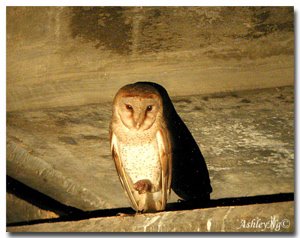 This incident occurred about noon some two to three years ago around an old longan tree (Dimocarpus longan). The tree was planted from seed 37 years ago and at that time the branches had been pruned and new shoots were sprouting, producing ‘bobs’ of new leaves. It was the favourite of seven to eight House Crows (Corvus splendens) that used it to rest after feeding.
This incident occurred about noon some two to three years ago around an old longan tree (Dimocarpus longan). The tree was planted from seed 37 years ago and at that time the branches had been pruned and new shoots were sprouting, producing ‘bobs’ of new leaves. It was the favourite of seven to eight House Crows (Corvus splendens) that used it to rest after feeding.
The tree was growing between our house and my uncle’s who lived next door. He was gardening below the tree when he noticed a couple of crows circling above and calling loudly. Curious, he looked closely at the tree to find a Barn Owl (Tyto alba) resting on a branch, hidden by the one of the leaves bobs.
He called all of us out to see the owl. Naturally the bird ignored us as it was more concerned with the crows above. As long as my uncle was working below the tree, the crows kept their distance and the owl was left unmolested.
After a while, when my uncle finished his work and got further away from the tree, the crows came nearer to the tree, calling frequently. They did not land but I think their cries were too much for the resting owl. It took off soon after. It has not returned until today.
At present, the tree is no longer being used by crows. We have kept its branches pruned to the maximum and it is not as shady as before.
Submitted by Chew Ping Ting; image of Barn Owl courtesy of Ashley Ng
This is a typical anti-predator behaviour and owls are popular targets, especially when caught resting during the daytime. Mobbing birds may include songbirds, crows, woodpeckers and those as small as hummingbirds. They make repeated dives as well as loud calls. They may or may not strike the predators. But cases have been known where owls were pecked on the eyes or the feathers. However, the owls are seldom hurt by these attacks and they seem to just ignore the mobbing birds, to eventually move away. It is possible that the mobbing birds know that it is safe to mob owls as these nocturnal birds are unable to attack the constantly moving mobbing birds.
Why birds mob predators? Probably to alert others of the presence of predator birds. Or to educate young birds on the identity of their enemies.









5 Responses
Hi, just like to check w u. Do u know if spore HDB allow rearing of owls??
Now why do we need to rear owls when we can enjoy them in the wild? I am sure AVA should be able to provide info on owl rearing.
Hi ! i encountered the same
experience today. I saw a collared scoop owl got mob by 2 crows…
i hope i saved it….
http://mymindisrojak.blogspot.com/2006/06/collared-scoop-owl-captured-in.html
I didn’t know about mobbing until today. Around noon, suddenly out of the southern sky a huge murder of crows (at least 100) came at my house, bent on attacking something in a tall Douglas fir. Although the fir had been stripped of branches lower down, the crown was dense, so I couldn’t see what they were after. I’ve heard owls in those trees before, and now that I’ve done some research on the Web, I’m tentatively concluding that this murder was after an owl. We also have hawks, bald eagles, and raccoons. I don’t know whether raccoons can cilmb that high (I do know that raccoons on the other side of town have taken up killing & eating cats & small dogs, not that that’s relevant to this comment, but maybe all the woodland denizens have gone mad as the builders have rapidly taken away their habitat). They circled & attacked one spot in the tree over & over again for about 30 minutes. Then they all flew off (I wasn’t watching — you can’t see the crown of that tree from inside my house and I was afraid to go outside, as were my cats. I heard them fly away (the crows, not my cats)). They scared me, and I had assumed that they killed whatever they were after. A couple of days ago I found a dead crow at the foot of that tree. Today after all the crows had left, I found another 2 dead crows. I’m curious whether the murder was trying to kill the owl or tell it to leave their roosting place alone or getting even for the first dead crow. And the two recently departed — could they have been accidentally killed by their manic compadres, or could an owl under attack have managed to kill them? What do you think?
Thanks for answering my questions. I wish I could climb up in that tree to see if there’s an owl nest there & whether the owl left for good or is still there — or would I be courting an eye-gouging? Anyway, the tree is a full grown Doug fir, and the only way I’d be able to get up it is if I had a pair of telephone lineman spikes. I’ve tried to look up in the tree but the branches/needles are too thick up there for me to see anything definitive. If I had the nerve to get up on my house (2-storey), I might be able to see something, but I’m pretty sure that’s suicidal.